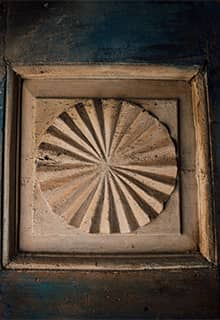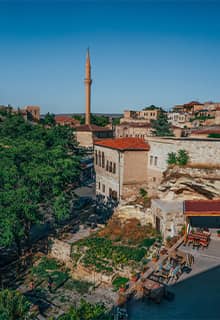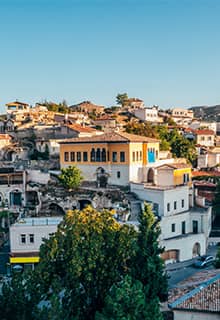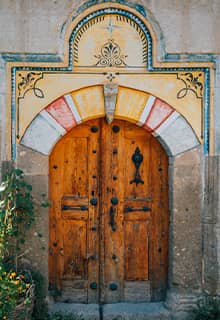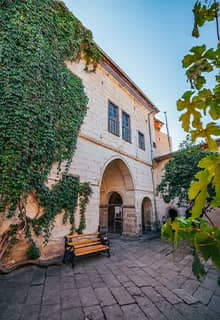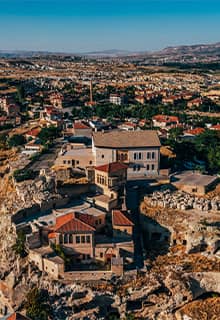

Mustafapaşa
Mustafapaşa, formerly known as Sinasos, is a small town with 1,300 inhabitants and stone buildings set along the feet of five surrounding hills. Mustafapaşa resembles an open-air museum with its civil architecture consisting of churches, mosques, and stone houses with carved and ornamented facades, balconies, and windows – all unique examples of the mastery of local stone cutters. Built in harmony with the region’s topography and climate, and presenting fine examples of stonemasonry and wood craftmanship, these 19th-century houses bear the traces of a brilliant culture. Here, you can get away from the crowds and spend time in an authentic, real-life Cappadocian town.
A Dip into the Olden Days
The history of Mustafapaşa traces back to prehistory with the artefacts discovered in the fruitful Damsa Valley, whose inhabitants were involved in commerce rather than agriculture. At the beginning of the 20th century, the town became a well-established, wealthy, and modern Cappadocian centre with educational and cultural institutions, and adopted modern art styles and living. Mustafapaşa was home to Rums, the Orthodox Christians of Türkiye, and Turks, and religion was one of the town’s key cultural components. Ottoman Rums built two public churches, more than 30 chapels, and numerous places of worship carved into stone around the village.
Among the oldest structures in the village are the ashlar stone Maraşoğlu Bridge, connecting two neighbourhoods; Agios Nikolaos Monastery and Agios Stefanos Church in the Manastır (Monastery) Valley; and the 17th-century ashlar stone Mustafapaşa Cami-i Kebir (Grand Mosque) in the village centre. The 19th-century Church of Constantine and Helena, featuring carvings of vines, a two-winged dragon, a two-headed eagle, and cherubim on its walls, should not be missed. The 19th-century Mehmet Şakir Paşa Madrasa, once a soup kitchen for the needy, is another impressive building that today is home to Kapadokya University, the first university to be founded in a village.
Ready to be Spoilt by Local Cuisine?
You can stay at the renovated traditional stone houses, typical to Ottoman-Cappadocian architecture, and dine at the restaurants either in renovated stone houses or unrestored traditional buildings. The most striking local specialties are pastries with legumes and testi kebabı, lamb shank stew cooked in earthenware pots – it should be noted that ceramics are one of the main livelihoods of the region. This land is also home to many vineyards and consequently, apart from wine, you can find products like grape vinegar, pickled grapes, and grape molasses. Local cuisine can be accompanied by local wines made with indigenous grape varieties such as emir.
Viticulture and Handicrafts for a Perfect Memento
The inhabitants of Mustafapaşa are famous for their handmade dolls called kitre, pottery, ceramics, and viticulture. Doll-making and ceramics are sustainable crafts that contribute to the common culture of the village. As for winemaking, the Anatolian viticulture is thousands of years old, and in the Middle Ages, winegrowers used to utilize pigeon guano as fertilizer for the volcanic soil of Cappadocia. Today, visitors love to visit the vineyards and witness the grape harvest in autumn.
The Cappadocia Art & History Museum, which opened as a private museum affiliated with the Ministry of Culture and Tourism after a comprehensive restoration, is also known as the Doll Museum. The dolls exhibited at the museum in Mustafapaşa, where the tradition of making kitre dolls in traditional clothes continues, tell us a lot about the folklore of Anatolia.
Looking for an Adventure? Come and See Life Engraved in Valleys!
The Gomeda-Üzengi Valley, next to the village of Mustafapaşa, is ideal for hikers. The valley begins in the village of Ayvalı and ends in the Üzengi district. The Alakara Church, just at the valley’s entrance, and the rock-carved Saint Basil’s Chapel, about a kilometer further, dating from the Iconoclastic period, are among the valley’s important religious structures. Along the path, you will come across endemic plants and butterflies. In addition, canals and tunnels of unknown origin add an air of mystery to the walk. At the end of the valley in Üzengi, the rock-carved dovecotes appear as a monumental structure. Some of these dovecotes had facades consisting of hundreds of windows, though only the perches survive to the present day.
Now You Deserve a Cup of Turkish Coffee…
When in Mustafapaşa, visitors can stop by the village of Şahinefendi to admire the ancient city of Sobesos, featuring an imposing meeting room and a hamam complex with colorful and impressive floor mosaics. Heading back to Mustafapaşa, it is a tradition to take a break for Turkish coffee at a kıraathane, a coffee shop on the main town square.


